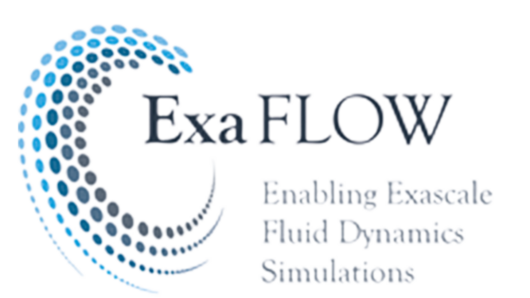We are surrounded by moving fluids (gases and liquids), be it breathing or the blood flow in our arteries; the flow around cars, ships, and airplanes; the changes in cloud formations or plankton transport in oceans; even formations of stars and galaxies are modeled as phenomena in fluid dynamics. Fluid dynamics simulations provide a powerful tool for the analysis of fluid flows and are an essential element of many industrial and academic problems. In fluid dynamics there is no limit to the size of the systems to be studied via numerical simulations. The complexities and nature of fluid flows, often combined with problems set in open domains, imply that the resources needed to computationally model problems of industrial and academic relevance are virtually unbounded. The main goal of this project is to address algorithmic challenges to enable the use of accurate simulation models in exascale environments.
The main goal of ExaFLOW is to address key algorithmic challenges in CFD (Computational Fluid Dynamics) to enable simulation at exascale, guided by a number of use cases of industrial relevance, and to provide open-source pilot implementations. Thus, driven by problems of practical engineering interest we focus on important simulation aspects, including:
- error control and adaptive mesh refinement in complex computational domains
- resilience and fault tolerance in complex simulations
- solver efficiency via mixed discontinuous and continuous Galerkin methods and appropriate optimized pre-conditioners
- heterogeneous modeling to allow for different solution algorithms in different domain zones
- evaluation of energy efficiency in solver design
- parallel input/output and in-situ compression for extreme data
In ExaFlow the High-Performance Computing Center Stuttgart (HLRS), in cooperation with the institute for Aero and Gas Dynamics (IAG) of the University of Stuttgart, forms the second biggest partner in the ExaFlow Consortium. In terms of Data reduction, HLRS is especially responsible for the evaluation and development of data reduction algorithms based on dynamic-mode decomposition (DMD) and emerging new ideas related to the Koopman Operator. Additionally, the task of researching energy efficiency and awareness is located at HLRS. Within this scope, the power consumption of different implementations using both high-resolution component level and lower-resolution node-level methods is measured as well as the impact of system level features (from frequency scaling to vectorization) on the total energy to solution is investigated.

